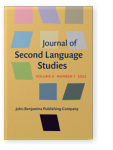Vol. 6:1 (2023) ► pp.95–118
Pitfalls of production data analysis for investigating L2 cognitive mechanism
An ontological realism perspective
This article addresses the pitfalls of performance analysis in investigating cognitive processing during second language (L2) learning. The problems that we discuss in this paper are twofold: (1) Assuming psychological variables to be ontological entities without meeting the criteria for ontological reality and (2) Inappropriateness of assessing abilities based on learner’s speaking or writing performance to investigate cognitive processes. By addressing these problems, we argue that some latent variables postulated by observing L2 performance do not exist in reality and emphasize the difficulty of interpreting cognitive mechanisms through performance analysis. We also enumerate some problems that arise from the epistemological perspectives of previous research practice (e.g., the bifurcation of contradictory hypotheses and their indeterminacy). Finally, two alternative approaches treating L2 performance are proposed. The implications of this line of discussion for future research are also discussed.
Article outline
- 1.Introduction
- 2.Ontological perspective on performance analysis
- 3.Skepticism of CAF as ontological entities
- 4.L2 performance as superficial phenomena that form a complex structure
- 5.Implications for future research
- Notes
-
References
For any use beyond this license, please contact the publisher at [email protected].
